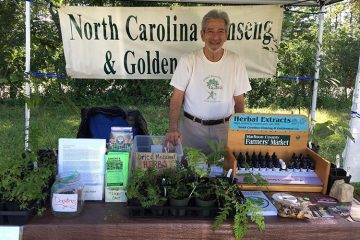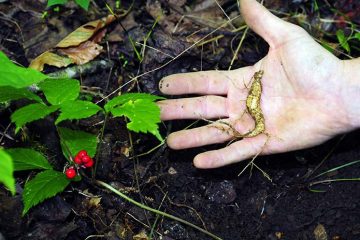
The Permaculture Activist (North America’s leading permaculture periodical),
www.permacultureactivist.net
Ginseng Speaks by Robert Eidus
Who will speak for the plants
The gentle flowers cloistered
In quiet meadow and lonely wood
Plants whose power is in their softness
Or in their strange difference?
Grandfather Ginseng will take the stand!
~ Lee Murray
Panax quinquefolium (American ginseng), a relative of the Chinese Panax ginseng, is a member of the Araliaceae, a family of approximately 700 plants which includes spikenard and English ivy. Though the Chinese have been using herbal medicines for approximately 5,000 years and writing down information for over 4,000 years, the earliest mention of Asian ginseng is in Shen Nong Ben Cao Jing, the world’s oldest comprehensive herbal document, written about 2,000 years ago.
American ginseng, which may have been used at least as long by Native Americans, lives in the rich, shaded, and moist coves of the mountains of the eastern United States and has a range from Georgia to Maine and west into the plains. On the West Coast, wild ginseng can be found in Oregon, Washington, and British Columbia. Like its Chinese cousin, “sang” as it’s called by the mountain folk, ginseng is a perennial herb, its stem and leaves die in winter but regrow in the spring. This shade dependent plant has a fleshy, slow-growing root and short stem, and is native to hardwood forests. It is best adapted to cool, temperate climates.
The Shapeshifter
Ginseng is magical and mysterious. Although there are general patterns of growth, sometimes it will trick you. Most perennial herbs look the same each season of their growth, but not ginseng. The first three years it changes its appearance each successive year. When the seedling first emerges, there are three small leaves (said to resemble wild strawberry) on a little stem. When it unfolds in year two, there is more growth to the central stem with two prongs, each producing three to five leaflets. In the third year, three prongs emerge from the leaf stem, each bearing a palmate cluster of five leaflets. Where the prongs are joined to the stem, white-green flowers appear which later ripen into bright red berries containing the seeds.
Ginseng is the only species I know that reveals the age of each and every plant, because when the stem falls off in the fall it leaves a scar on the neck or curl. The new bud emerges just above the old scar. Just count up the scars to determine the approximate age of the plant. Each year the plant grows, more prongs may be added. As a rule four prongs indicate a seven-year-old plant that is medicinally mature. Ginseng can continue to grow more prongs as it gets older. I remember seeing a five-prong, which is getting rare, and two of the prongs had five leaflets but two had six and one had seven.
Above the ground ginseng plants of a similar age look pretty much alike, but when you look below the surface, wild roots will vary greatly in appearance. Cultivated roots tend to be more uniform. Every now and then you can find a mature root with a human-like shape, with arms, legs, and body. These were prized by the Chinese whose ideogram for ginseng means “essence of the earth in the form of a man.”
At Home in the Woods
Ginseng needs hardwood forests to block out the sun and to provide a roof. It thrives in mixed groves of poplar, beech, maple, and dogwood. If the trees above are cut down, ginseng’s root and seeds dry out, a fatal condition. Clearcuts thus destroy habitat for this threatened species. Shade from the forest canopy keeps the soil cool, the roots stabilize the earth, and the trees provide a rich annual mulch of leaves. Herbaceous plant companions commonly found near ginseng include trillium (Trillium spp.), cohosh (Caulophyllum thalactroides -blue, Cimicifuga racemosa-black), jack-in-the-pulpit (Arisaema atrorubens), wild yam (Dioscorea villosa), goldenseal (Hydrastis canadensis), and Solomon’s seal (Polygonatum biflorum).
Some of these companions help the ginseng to survive. Research by Dr. Jeanine Davis, with the North Carolina State University Agricultural Research station, has shown that goldenseal can clean up beds of ginseng infected with fungal disease. Since ginseng has a problem with fungi, goldenseal’s anti-fungal properties make it a choice and valuable companion. Many Native American tribes consider ginseng and goldenseal to be brother and sister plants because they grow well together in the wild.
The Ginseng Industry
Most Asian and American ginseng is grown in an environment that is not natural. How did this happen?
Panax ginseng has been in increasingly short supply, especially in the last four hundred years. With population growth and the steady loss of forest cover to agriculture, the governments of China, Korea, and Japan long ago took measures to ensure a supply of this precious medicine. For many years they licensed the growing of ginseng on plantations in guarded walled compounds, but only in the last century have these growing techniques been documented. Although Asian growers were successful with ginseng in a monocultural environment, very strict rules and procedures were required to achieve healthy plants.
The labor-intensive procedures developed in East Asia were largely abandoned as chemical fungicides and nasty stuff like DDT became available. Although, the worst of the chemical sprays are not used in America today, most cultivated ginseng, including woods-grown ginseng, is still heavily sprayed worldwide. Studies in recent years have shown fungicidal residues to be cumulative and toxic in cultivated roots. This discovery, along with recent EPA fines levied against Wisconsin ginseng growers who had used toxic biocides, has sounded a worldwide wake-up call to the dangers of contamination of this great plant.
At the Convention on International Trade in Endangered Species of Wild Flora (CITES), 80 countries identified American ginseng as one of the many plants that need international protection. The CITES agreements were implemented in the US in 1977 and are administered by the U.S. Fish and Wildlife Service. Despite rules and regulation governing the export of American ginseng, we are still losing this plant in the wild due to over-harvesting. Currently, more than 90% of the ginseng harvested in America is exported to Hong Kong and other Pacific Rim markets. With worldwide demand steadily increasing, the situation becomes ever more critical for this powerful tonic.
An Awakening
But I didn’t learn this until 1977, when, at a health conference in Hot Springs, North Carolina, I met Hawk Little John, a Cherokee medicine man, who discussed ginseng and goldenseal. His enthusiasm and respect for plants seeded in me an ever-deepening relationship to the green world.
In 1992, Dr. Jeanine Davis of the N.C. Dept. of Agriculture, organized an historic conference on ginseng, near Asheville, where I learned much about the wonderful nature of the plant and techniques for growing it. After the conference, I went back to my land in Madison County, and with the help of a knowledgeable friend, found ginseng growing. When Paul found the plant he gave a Native American war cry to the forest spirits. After praying, we harvested this root and dropped some tobacco as an offering. It was a wonderful day.
A couple of months later, I founded the North Carolina Ginseng and Goldenseal Company in Marshall, but it was not until 1995 that I left my real estate job and decided to grow and sell medicinal herbs as a full-time business. This was not an easy choice, for though I was an experienced gardener, I was still new to forest farming and botany. But following a weeklong illness I reappraised my life and saw that selling real estate was not something I did very well. The ginseng plants spoke to me during that feverish time and asked me to help them survive. Definitely a favor worth returning.
I agreed with the plants to become a role model for the new wave of ginseng farmers.
I soon found myself trying to convince others to attempt farming in the woods. Unexpectedly, my New York accent and urban background turned out to be a big plus. If I could learn to grow high quality ginseng there was no reason others couldn’t also be successful medicinal herb farmers.
As I became a spokesperson for the plants, I knew that the plants, especially ginseng and goldenseal, would do their part to help me to the next level. An unexpected assist came in the form of a request from the owner of New Frontiers magazine to review Eliot Cowan’s Plant Spirit Medicine. I loved the book and gave it an enthusiastic review. By learning about the spirit world of plants, I came to realize that I could communicate with them and that I had a special ally in ginseng. My heart had no problem understanding this psychic relationship. My body followed.
Thus, the North Carolina Ginseng & Goldenseal Co. was born with the primary goals of actively re-seeding both plants in the wild and encouraging their organic cultivation in the woods. In the last five years we have laid a strong foundation for both aspects of this work. In that time the United Plant Savers, a non-profit organization dedicated to rescuing endangered populations of wild botanicals, was founded, and the land I steward, Eagle Feather Organic Farm, became a U.P.S. Native Botanical Sanctuary. At the same time research into organic methods of cultivating ginseng has given us some important tools. Following Dr. Davis’ work, we’ve learned to spray extracts of goldenseal on the ginseng beds to control soil-borne funguses in the fall. And now a group of people are conducting research into the use of horsetail (Equisetum arvense), another native plant, as a spray to curb airborne fungus in the spring.
A Growing Challenge
In some ways, however, the situation for ginseng is getting worse. Though more information is available today and interest in growing and in conservation is high, the harvest of ginseng is increasing. Last year 11,000 pounds were legally exported to Hong Kong from North Carolina. This is 2,000 pounds more than the year before. Five and a half tons may not seem like much until you consider that it takes approximately 400 dried ginseng roots to make a pound. That would mean that over four million roots were harvested in 1999. During the same year I sold 21 pounds of ginseng seed to Madison County Extension Service. That seed was divided and sold by the ounce to local farmers. If all the plants come up, (350 seeds to an ounce), that would be about 500,000 first-year plants, nowhere close to replacing all the plants taken in the North Carolina mountains. There are only a few of us selling ginseng seed in this region, and only one other Extension office, in Yancey County, is offering this program to area landowners. That leaves 31 other mountain county Extension offices pushing Xmas trees, blueberries, strawberries, or other non-herbal commodities.
You do not have to be a genius to realize that the plants are losing the battle for survival. The two-leggeds must rally round these beneficent plant alies and help save them from greed and extinction.
Robert Eidus grows ginseng near Marshall, NC. Contact him at eidusbiz@gmail.com






